 W
WA black hole is a region of spacetime where gravity is so strong that nothing—no particles or even electromagnetic radiation such as light—can escape from it. The theory of general relativity predicts that a sufficiently compact mass can deform spacetime to form a black hole.
 W
WA binary black hole (BBH) is a system consisting of two black holes in close orbit around each other. Like black holes themselves, binary black holes are often divided into stellar binary black holes, formed either as remnants of high-mass binary star systems or by dynamic processes and mutual capture, and binary supermassive black holes believed to be a result of galactic mergers.
 W
WAn intermediate-mass black hole (IMBH) is a class of black hole with mass in the range 102–105 solar masses: significantly more than stellar black holes but less than the 105–109 solar mass supermassive black holes. Several IMBH candidate objects have been discovered in our galaxy and others nearby, based on indirect gas cloud velocity and accretion disk spectra observations of various evidentiary strength.
 W
WA supermassive black hole is the largest type of black hole, with mass on the order of millions to billions of times the mass of the Sun (M☉). Black holes are a class of astronomical objects that have undergone gravitational collapse, leaving behind spheroidal regions of space from which nothing can escape, not even light. Observational evidence indicates that almost every large galaxy has a supermassive black hole at the galaxy's center. The Milky Way has a supermassive black hole in its Galactic Center, which corresponds to the location of Sagittarius A*. Accretion of interstellar gas onto supermassive black holes is the process responsible for powering active galactic nuclei and quasars.
 W
WAn accretion disk is a structure formed by diffuse material in orbital motion around a massive central body. The central body is typically a star. Friction causes orbiting material in the disk to spiral inward towards the central body. Gravitational and frictional forces compress and raise the temperature of the material, causing the emission of electromagnetic radiation. The frequency range of that radiation depends on the central object's mass. Accretion disks of young stars and protostars radiate in the infrared; those around neutron stars and black holes in the X-ray part of the spectrum. The study of oscillation modes in accretion disks is referred to as diskoseismology.
 W
WA black hole cosmology is a cosmological model in which the observable universe is the interior of a black hole. Such models were originally proposed by theoretical physicist Raj Pathria, and concurrently by mathematician I. J. Good.
 W
WThe black hole information paradox is a puzzle resulting from the combination of quantum mechanics and general relativity. Calculations suggest that physical information could permanently disappear in a black hole, allowing many physical states to devolve into the same state. This is controversial because it violates a core precept of modern physics—that, in principle, the value of a wave function of a physical system at one point in time should determine its value at any other time. A fundamental postulate of the Copenhagen interpretation of quantum mechanics is that complete information about a system is encoded in its wave function up to when the wave function collapses. The evolution of the wave function is determined by a unitary operator, and unitarity implies that information is conserved in the quantum sense.
 W
WIn physics, black hole thermodynamics is the area of study that seeks to reconcile the laws of thermodynamics with the existence of black-hole event horizons. As the study of the statistical mechanics of black-body radiation led to the advent of the theory of quantum mechanics, the effort to understand the statistical mechanics of black holes has had a deep impact upon the understanding of quantum gravity, leading to the formulation of the holographic principle.
 W
WA brightest cluster galaxy (BCG) is defined as the brightest galaxy in a cluster of galaxies. BCGs include the most massive galaxies in the universe. They are generally elliptical galaxies which lie close to the geometric and kinematical center of their host galaxy cluster, hence at the bottom of the cluster potential well. They are also generally coincident with the peak of the cluster X-ray emission.
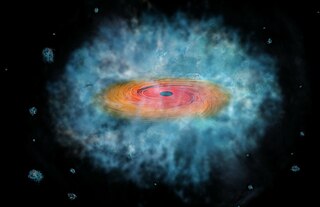 W
WDirect collapse black holes are high-mass black hole seeds, putatively formed within the redshift range , when the Universe was about 100-250 million years old. Unlike seeds formed from the first population of stars (also known as Population III stars), direct collapse black hole seeds are formed by a direct, general relativistic instability. They are very massive, with a typical mass at formation of ~105 M☉. This category of black hole seeds was originally proposed theoretically to alleviate the challenge in building supermassive black holes already at redshift , as numerous observations to date have confirmed.
 W
WThe ergosphere is a region located outside a rotating black hole's outer event horizon. Its name was proposed by Remo Ruffini and John Archibald Wheeler during the Les Houches lectures in 1971 and is derived from the Greek word ἔργον (ergon), which means "work". It received this name because it is theoretically possible to extract energy and mass from this region. The ergosphere touches the event horizon at the poles of a rotating black hole and extends to a greater radius at the equator. A black hole with modest angular momentum has an ergosphere with a shape approximated by an oblate spheroid, while faster spins produce a more pumpkin-shaped ergosphere. The equatorial (maximal) radius of an ergosphere is the Schwarzschild radius, the radius of a non-rotating black hole. The polar (minimal) radius is also the polar (minimal) radius of the event horizon which can be as little as half the Schwarzschild radius for a maximally rotating black hole.
 W
WIn astrophysics, an event horizon is a boundary beyond which events cannot affect an observer. The term was coined by Wolfgang Rindler.
 W
WIn astrophysics, an extreme mass ratio inspiral (EMRI) is the orbit of a relatively light object around a much heavier object, that gradually decays due to the emission of gravitational waves. Such systems are likely to be found in the centers of galaxies, where stellar mass compact objects, such as stellar black holes and neutron stars, may be found orbiting a supermassive black hole. In the case of a black hole in orbit around another black hole this is an extreme mass ratio binary black hole. The term EMRI is sometimes used as a shorthand to denote the emitted gravitational waveform as well as the orbit itself.
 W
WThe study of black holes, gravitational sources so massive that even light cannot escape from them, goes back to the late 18th century. Major advances in understanding were made throughout the first half of the 20th century, with contributions from many prominent mathematical physicists, though the term black hole was only coined in 1967. With the development of general relativity other properties related to these entities came to be understood, and their features have been included in many notable works of fiction.
 W
WFuzzballs are theorized by some superstring theory scientists to be the true quantum description of black holes. The theory attempts to resolve two intractable problems that classic black holes pose for modern physics:The information paradox wherein the quantum information bound in in‑falling matter and energy entirely disappears into a singularity; that is, the black hole would undergo zero physical change in its composition regardless of the nature of what fell into it. The singularity at the heart of the black hole, where conventional black hole theory says there is infinite spacetime curvature due to an infinitely intense gravitational field from a region of zero volume. Modern physics breaks down when such parameters are infinite and zero.
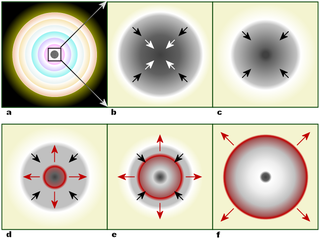 W
WGravitational collapse is the contraction of an astronomical object due to the influence of its own gravity, which tends to draw matter inward toward the centre of gravity. Gravitational collapse is a fundamental mechanism for structure formation in the universe. Over time an initial, relatively smooth distribution of matter will collapse to form pockets of higher density, typically creating a hierarchy of condensed structures such as clusters of galaxies, stellar groups, stars and planets.
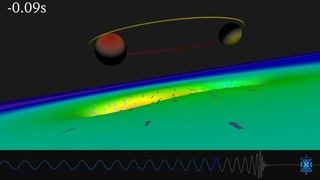 W
WGravitational waves are disturbances in the curvature of spacetime, generated by accelerated masses, that propagate as waves outward from their source at the speed of light. They were proposed by Henri Poincaré in 1905 and subsequently predicted in 1916 by Albert Einstein on the basis of his general theory of relativity. Gravitational waves transport energy as gravitational radiation, a form of radiant energy similar to electromagnetic radiation. Newton's law of universal gravitation, part of classical mechanics, does not provide for their existence, since that law is predicated on the assumption that physical interactions propagate instantaneously – showing one of the ways the methods of classical physics are unable to explain phenomena associated with relativity.
 W
W1E1740.7-2942, or the Great Annihilator, is a Milky Way microquasar, located near the Galactic Center on the sky. It likely consists of a black hole and a companion star. It is one of the brightest X-ray sources in the region around the Galactic Center.
 W
WGW190521 was a gravitational wave signal resulting from the merger of two black holes. It was possibly associated with a coincident flash of light; if this association is correct, the merger would have occurred near a third supermassive black hole. The event was observed by the LIGO and Virgo detectors on 21 May 2019 at 03:02:29 UTC, and published on 2 September 2020. The event was 17 billion light years away from Earth, within a 765 deg2 area towards Coma Berenices, Canes Venatici, or Phoenix.
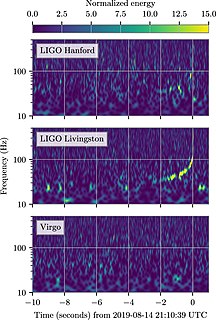 W
WGW 190814 was a gravitational wave (GW) signal observed by the LIGO and Virgo detectors on 14 August 2019 at 21:10:39 UTC, and having a signal-to-noise ratio of 25 in the three-detector network. The signal was associated with the astronomical superevent S190814bv, located 790 million light years away, in location area 18.5 deg2 towards Cetus or Sculptor. No optical counterpart was discovered despite an extensive search of the probability region.
 W
WHawking radiation is black-body radiation that is predicted to be released by black holes, due to quantum effects near the black hole event horizon. It is named after the physicist Stephen Hawking, who provided a theoretical argument for its existence in 1974.
 W
WThe holographic principle is a tenet of string theories and a supposed property of quantum gravity that states that the description of a volume of space can be thought of as encoded on a lower-dimensional boundary to the region—such as a light-like boundary like a gravitational horizon. First proposed by Gerard 't Hooft, it was given a precise string-theory interpretation by Leonard Susskind, who combined his ideas with previous ones of 't Hooft and Charles Thorn. As pointed out by Raphael Bousso, Thorn observed in 1978 that string theory admits a lower-dimensional description in which gravity emerges from it in what would now be called a holographic way. The prime example of holography is the AdS/CFT correspondence.
 W
WIn orbital mechanics, decay is a gradual decrease of the distance between two orbiting bodies at their closest approach over many orbital periods. These orbiting bodies can be a planet and its satellite, a star and any object orbiting it, or components of any binary system. Orbits do not decay without some friction-like mechanism which transfers energy from the orbital motion. This can be any of a number of mechanical, gravitational, or electromagnetic effects. For bodies in low Earth orbit, the most significant effect is atmospheric drag.
 W
WThe Kerr metric or Kerr geometry describes the geometry of empty spacetime around a rotating uncharged axially-symmetric black hole with a quasispherical event horizon. The Kerr metric is an exact solution of the Einstein field equations of general relativity; these equations are highly non-linear, which makes exact solutions very difficult to find.
 W
WNGC 3818 is an elliptical galaxy in the Constellation Virgo. It is at a distance of about 77 million light-years away from Earth. In the center of NGC 3818 lies a supermassive black hole. NGC 3818 was discovered by William Herschel on March 5, 1785.
 W
WThe no-hair theorem states that all black hole solutions of the Einstein–Maxwell equations of gravitation and electromagnetism in general relativity can be completely characterized by only three externally observable classical parameters: mass, electric charge, and angular momentum. All other information about the matter that formed a black hole or is falling into it "disappears" behind the black-hole event horizon and is therefore permanently inaccessible to external observers. Physicist John Archibald Wheeler expressed this idea with the phrase "black holes have no hair," which was the origin of the name. In a later interview, Wheeler said that Jacob Bekenstein coined this phrase.
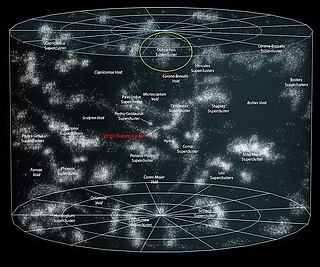 W
WOphiuchus Supercluster is a nearby galaxy supercluster in the constellation Ophiuchus. The supercluster forms the far wall of the Ophiuchus Void; it may also be connected in a filament, with the Pavo-Indus-Telescopium Supercluster and the Hercules Supercluster. This supercluster is centered on the cD cluster Ophiuchus Cluster, and has at least two more galaxy clusters, four more galaxy groups, several field galaxies, as members.
 W
WIn orbital mechanics, decay is a gradual decrease of the distance between two orbiting bodies at their closest approach over many orbital periods. These orbiting bodies can be a planet and its satellite, a star and any object orbiting it, or components of any binary system. Orbits do not decay without some friction-like mechanism which transfers energy from the orbital motion. This can be any of a number of mechanical, gravitational, or electromagnetic effects. For bodies in low Earth orbit, the most significant effect is atmospheric drag.
 W
WFeryal Özel is a Turkish astrophysicist born in Istanbul, Turkey, specializing in the physics of compact objects and high energy astrophysical phenomena. As of 2020, Özel is a professor at the University of Arizona in Tucson, in the Astronomy Department and Steward Observatory.
 W
WA photon sphere or photon circle is an area or region of space where gravity is so strong that photons are forced to travel in orbits. The radius of the photon sphere, which is also the lower bound for any stable orbit, is, for a Schwarzschild black hole:
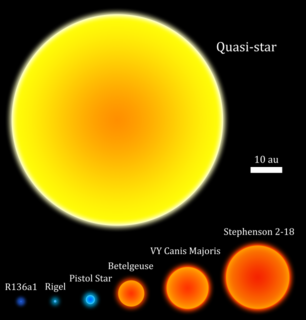 W
WA quasi-star is a hypothetical type of extremely massive and luminous star that may have existed early in the history of the Universe. Unlike modern stars, which are powered by nuclear fusion in their cores, a quasi-star's energy would come from material falling into a black hole at its core.
 W
WIn physics and astronomy, the Reissner–Nordström metric is a static solution to the Einstein–Maxwell field equations, which corresponds to the gravitational field of a charged, non-rotating, spherically symmetric body of mass M. The analogous solution for a charged, rotating body is given by the Kerr–Newman metric.
 W
WA rotating black hole is a black hole that possesses angular momentum. In particular, it rotates about one of its axes of symmetry.
 W
WIn Einstein's theory of general relativity, the Schwarzschild metric is the solution to the Einstein field equations that describes the gravitational field outside a spherical mass, on the assumption that the electric charge of the mass, angular momentum of the mass, and universal cosmological constant are all zero. The solution is a useful approximation for describing slowly rotating astronomical objects such as many stars and planets, including Earth and the Sun. It was found by Karl Schwarzschild in 1916, and around the same time independently by Johannes Droste, who published his much more complete and modern-looking discussion only four months after Schwarzschild.
 W
WThe Schwarzschild radius is a physical parameter that shows up in the Schwarzschild solution to Einstein's field equations, corresponding to the radius defining the event horizon of a Schwarzschild black hole. It is a characteristic radius associated with every quantity of mass. The Schwarzschild radius was named after the German astronomer Karl Schwarzschild, who calculated this exact solution for the theory of general relativity in 1916.
 W
WIn astrophysics, spaghettification is the vertical stretching and horizontal compression of objects into long thin shapes in a very strong non-homogeneous gravitational field; it is caused by extreme tidal forces. In the most extreme cases, near black holes, the stretching is so powerful that no object can withstand it, no matter how strong its components. Within a small region the horizontal compression balances the vertical stretching so that small objects being spaghettified experience no net change in volume.
 W
WA black hole spin-flip occurs when the spin axis of a rotating black hole undergoes a sudden change in orientation due to absorption of a second (smaller) black hole. Spin-flips are believed to be a consequence of galaxy mergers, when two supermassive black holes form a bound pair at the center of the merged galaxy and coalesce after emitting gravitational waves. Spin-flips are significant astrophysically since a number of physical processes are associated with black hole spins; for instance, jets in active galaxies are believed to be launched parallel to the spin axes of supermassive black holes. A change in the rotation axis of a black hole due to a spin-flip would therefore result in a change in the direction of the jet.
 W
WThe surface gravity, g, of an astronomical object is the gravitational acceleration experienced at its surface at the equator, including the effects of rotation. The surface gravity may be thought of as the acceleration due to gravity experienced by a hypothetical test particle which is very close to the object's surface and which, in order not to disturb the system, has negligible mass.
 W
WThe Thorne–Hawking–Preskill bet was a public bet on the outcome of the black hole information paradox made in 1997 by physics theorists Kip Thorne and Stephen Hawking on the one side, and John Preskill on the other, according to the document they signed 6 February 1997, as shown in Hawking's The Universe in a Nutshell.
 W
WIn general relativity, a white hole is a hypothetical region of spacetime and singularity which cannot be entered from the outside, although energy-matter, light and information can escape from it. In this sense, it is the reverse of a black hole, which can be entered only from the outside and from which energy-matter, light and information cannot escape. White holes appear in the theory of eternal black holes. In addition to a black hole region in the future, such a solution of the Einstein field equations has a white hole region in its past. However, this region does not exist for black holes that have formed through gravitational collapse, nor are there any observed physical processes through which a white hole could be formed.
 W
WA wormhole is a speculative structure linking disparate points in spacetime, and is based on a special solution of the Einstein field equations.